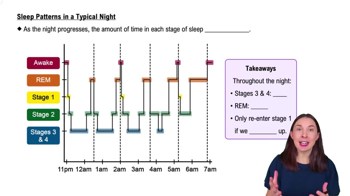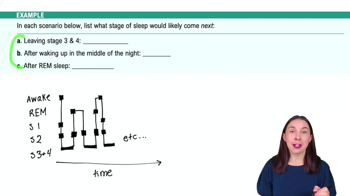Table of contents
- 1. Introduction to Psychology1h 43m
- 2. Psychology Research2h 20m
- 3. Biological Psychology2h 41m
- 4. Sensation and Perception28m
- 5. Consciousness and Sleep32m
- 6. Learning41m
- 7. Memory34m
- 8. Cognition37m
- 9. Emotion and Motivation35m
- 10. Developmental Psychology33m
- 11. Personality48m
- 12. Social Psychology41m
- 13. Stress and Health41m
- 14. Psychological Disorders44m
- 15. Treatment47m
5. Consciousness and Sleep
Sleep
Struggling with Psychology?
Join thousands of students who trust us to help them ace their exams!Watch the first videoMultiple Choice
Select the answer choice that correctly defines the EEG feature.
A
Beta waves: lowest frequency & highest amplitude.
B
Sleep spindles: very high amplitude.
C
K complex: very high frequency.
D
Delta waves: lowest frequency & highest amplitude.
 Verified step by step guidance
Verified step by step guidance1
Understand the context: The problem is asking for the correct definition of an EEG feature, specifically focusing on the characteristics of different brain wave patterns.
Review the characteristics of each EEG feature mentioned: Beta waves, Sleep spindles, K complex, and Delta waves.
Recall that Beta waves are associated with active thinking and alertness, typically having a high frequency and low amplitude.
Remember that Sleep spindles are bursts of oscillatory brain activity visible on an EEG that occur during stage 2 of sleep, characterized by a frequency of 12-16 Hz and moderate amplitude.
Identify that Delta waves are associated with deep sleep and are characterized by having the lowest frequency and highest amplitude among the brain waves, which matches the correct answer choice.

 3:25m
3:25mWatch next
Master Circadian Rhythms with a bite sized video explanation from Hannah Gordils
Start learningRelated Videos
Related Practice


































































































![Race, Genes and IQ Differences | Bret Weinstein [Mini Clip]](https://img.youtube.com/vi/IztL_m3pd70/mqdefault.jpg)



































































































